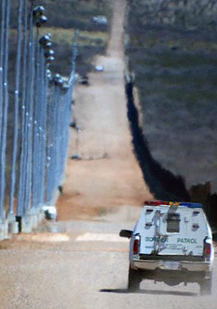Border Wall
 The U.S.-Mexico border wall stops jaguars and other wildlife species dead in their tracks. It wreaks havoc on animal habitat, disrupts migratory wildlife patterns, and alters fragile ecosystems. Although physical barriers, roads, high-powered lighting, cameras, and sensors are still being installed, the wall has already inflicted serious damage to wildlife and could be referred to as a fence of extinction. The wall clearly blocks wildlife but not people. At an average cost of millions of dollars per mile, it has been referred to as a mere “speed bump in the desert.”
The U.S.-Mexico border wall stops jaguars and other wildlife species dead in their tracks. It wreaks havoc on animal habitat, disrupts migratory wildlife patterns, and alters fragile ecosystems. Although physical barriers, roads, high-powered lighting, cameras, and sensors are still being installed, the wall has already inflicted serious damage to wildlife and could be referred to as a fence of extinction. The wall clearly blocks wildlife but not people. At an average cost of millions of dollars per mile, it has been referred to as a mere “speed bump in the desert.”
The U.S. Department of Homeland Security used its authority to waive more than 30 environmental and cultural laws in a rush to construct 670 miles of barriers before the Bush administration left office. As the agency announced that reaching its goal was unlikely, it was overwhelmed with cost overruns and legal challenges. President Obama initially took steps to rely more on virtual technology to monitor the region, yet Obama’s administration committed to finishing the remaining miles that were still under contract or construction.
Without proper environmental analysis, the flow of wildlife is being heavily impacted along the length of the border. The border wall fragments valuable wildlife habitat in ecologically rich areas such as Organ Pipe Cactus National Monument, the San Pedro Riparian National Conservation Area, and the Lower Rio Grande Valley Wildlife Refuge.
Within the border region lives a number of endangered and threatened species, including ocelots, Gila monsters, Sonoran pronghorn antelope, and, of course, jaguars. NJP is working to protect the source population for jaguars returning to the U.S. so that when the border wall is no more and the obstacles are removed, the cats will be there.

